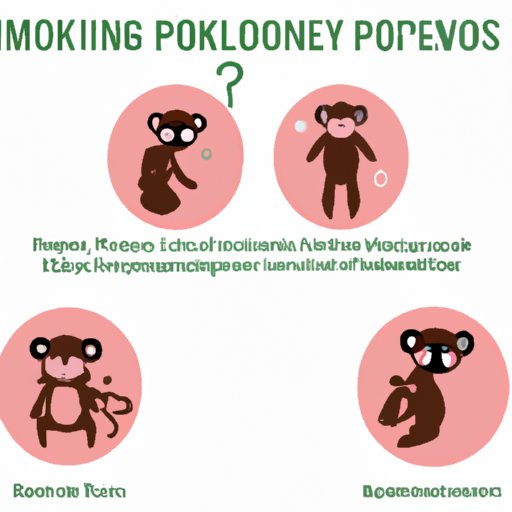
Introduction
Monkeypox is a rare but potentially serious viral disease that belongs to the same family as smallpox. The virus was first identified in monkeys in 1958 and in humans in 1970. Monkeypox outbreaks have been reported mainly in central and Western Africa, and more recently in Asia and North America. While monkeypox is not as deadly as smallpox, it can cause severe illness in some cases.
7 Common Symptoms of Monkeypox You Need to Know About
The symptoms of monkeypox can range from mild to severe, and vary from one person to another. Here are the seven most common symptoms of monkeypox:
Fever
One of the earliest symptoms of monkeypox is fever. The fever usually starts suddenly and can range from a low-grade fever to a high fever.
Rash
A rash is another common symptom of monkeypox. The rash usually starts on the face then spreads to other parts of the body. The rash usually evolves from small, raised, and fluid-filled blisters to pustules then scabs.
Fatigue
Fatigue is another early symptom of monkeypox. It can be mild or severe and it’s difficult to see the difference between the fatigue caused by monkeypox and that of other viral infections.
Headache
Headache is a symptom that often accompanies fever. It can be mild or severe and is usually located in the forehead and temples.
Muscles aches and pains
Muscle aches and pains are another common symptom of monkeypox. These can be mild or severe, and can affect any part of the body.
Swollen lymph nodes
Swollen lymph nodes often accompany the rash in patients with monkeypox. The lymph nodes are typically found in the armpit, neck, and groin area.
Chills
Chills can be another early symptom of monkeypox. The chills may be accompanied by fever, headache, and muscle aches.
Monkeypox Symptoms: Early Signs and Symptoms to Look Out For
Smallpox-like lesions on face and body
Smallpox-like lesions are a classic sign of monkeypox. These lesions are usually found on the face, trunk, and limbs. They start as small, raised, fluid-filled blisters that evolve into pustules and then scabs.
General feeling of discomfort
A general feeling of discomfort may also be present in patients with monkeypox. This can manifest as malaise, fatigue, and general body aches and pains.
A Guide to Identifying Symptoms of Monkeypox
In addition to the common symptoms of monkeypox, there are other physical symptoms, respiratory symptoms, and digestive symptoms that can occur. Here’s a list of potential complications of monkeypox.
Physical symptoms
– Rash
– Lesions
– Blisters
– Pustules
– Scabs
Respiratory symptoms
– Cough
– Shortness of breath
Digestive symptoms
– Nausea
– Vomiting
List of potential complications
– Eye infections
– Infections of internal organs
– Encephalitis
– Meningitis

Understanding Monkeypox Symptoms: What to Expect
During the early stages, monkeypox can be difficult to diagnose because the symptoms can resemble those of other viral illnesses such as the flu or chickenpox. The progression of monkeypox symptoms typically follows a specific pattern.
How long symptoms can last
Symptoms of mild monkeypox usually last between two and four weeks, while severe cases can last for several months.
When to seek medical attention
If you suspect that you or someone you know may have monkeypox, it is crucial to seek medical attention immediately. Treatment is aimed at reducing symptoms and preventing complications.
The Most Common Monkeypox Symptoms Explained
Here’s a brief overview of the common symptoms of monkeypox and a detailed explanation of each symptom.
Overview of symptoms
– Fever
– Rash
– Fatigue
– Headache
– Muscle aches and pains
– Swollen lymph nodes
– Chills
Detailed explanation of each symptom
– Fever: a sudden onset of elevated temperature
– Rash: small, raised, fluid-filled blisters that evolve into pustules and then scabs
– Fatigue: feeling of exhaustion or weakness that is not relieved by rest
– Headache: a pain or discomfort in the head
– Muscle aches and pains: pain or discomfort in the muscles
– Swollen lymph nodes: enlargement of the lymph nodes
– Chills: a sudden feeling of cold accompanied by shivering and fever
How to Recognize Monkeypox: Symptoms and Treatment Options
The diagnosis of monkeypox is based on clinical symptoms and laboratory tests. Treatment options include supportive care and managing symptoms.
How monkeypox is typically diagnosed
The diagnosis of monkeypox can be confirmed by laboratory tests such as PCR (polymerase chain reaction) testing, virus isolation, and serology.
Treatment options and strategies
There is no specific treatment for monkeypox, but supportive care can help manage symptoms. This may include intravenous fluids, pain relief, and fever-reducing medications. In some cases, antiviral medication may be used.
Prevention measures
Prevention measures include avoiding contact with infected animals and their body fluids, reducing exposure to infected humans, and practicing good hygiene.
Monkeypox Symptoms: Everything You Need to Know to Stay Safe
If you experience symptoms of monkeypox, it is important to seek medical attention immediately. In addition, practicing good hygiene, maintaining a healthy diet and lifestyle, and avoiding contact with monkeys and other infected animals can help prevent the spread of monkeypox.
Recap of information
– Monkeypox is a rare but serious viral disease
– Symptoms of monkeypox include fever, rash, fatigue, headache, muscle aches, swollen lymph nodes, and chills
– Seek medical attention immediately if you suspect you may have monkeypox
– Prevention measures include avoiding contact with infected animals and practicing good hygiene
Prevention tips
– Avoid contact with monkeys and other infected animals
– Wear gloves and protective clothing when handling sick animals
– Practice good hand hygiene
– Avoid close contact with individuals diagnosed with monkeypox
Conclusion
Monkeypox is a rare but serious viral disease that can cause severe illness in some cases. Early treatment is essential to manage symptoms and prevent complications. By being cautious around animals and practicing good hygiene, individuals can help prevent the spread of monkeypox and stay safe.




